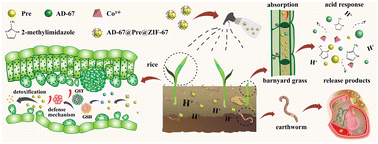A MOF-based pH-responsive dual controlled-release system for herbicide pretilachlor and safener AD-67 delivery that enhances the herbicidal efficacy and reduces side effects†
Abstract
Pretilachlor (Pre) is an efficient and broad-spectrum pre-seedling herbicide; however, the excessive use of the Pre traditional formulation causes phytotoxicity to rice seedlings (Oryza sativa), toxicity to soil organisms, and great environmental pollution. 4-(Dichloroacetyl)-1-oxa-4-azospiro[4,5]decane (AD-67) is a herbicide safener and it can reduce the phytotoxicity of herbicides to plants, but it degrades slowly in the aquatic environment, and extensive application leads to a wide range of negative environmental impacts. To reduce the frequency of application and increase the safety of non-target organisms, for the first time, an herbicide-safener nano-double controlled release system AD-67@Pre@ZIF-67 was successfully constructed. Pre was encapsulated in ZIF-67, metal–organic framework (MOF), and the safener AD-67 was adsorbed by self-assembly on the surface of the MOF. The release rates of Pre and AD-67 increased with the decrease in the pH value. With the lowest pH value (5.8), Pre and AD-67 were released 57% and 78% rapidly in the first 2 h, respectively, then were slowly released, and the overall releases were 86% and 96% on the 7th day, respectively. Hence, the safener AD-67 can be released quickly to protect the rice seedlings from injury caused by Pre, while Pre can release slowly from nano-double controlled release for a longer duration and show lower phytotoxicity to rice. Compared to the pre-treatment, the relative root length, relative plant height, and relative fresh weight values of rice seedlings treated with AD-67@Pre@ZIF-67 were increased by 50%, 40%, and 62%, respectively. AD-67@Pre@ZIF-67 also had lower acute toxicity to earthworms (Eisenia foetida), with the 24 h and 48 h LC50 values, which were 6 times and 5 times than that of Pre, respectively. The results showed that AD-67@Pre@ZIF-67 did not only improve the herbicidal activity to target weed barnyard grass (Echinochloa crusgalli) but also met the requirements of minimizing the adverse effects of herbicides on crop plants and environments. This shows the great application prospects in modern agriculture.

- This article is part of the themed collections: Nano-bio interactions and Environmental Science: Nano Recent HOT Articles


 Please wait while we load your content...
Please wait while we load your content...